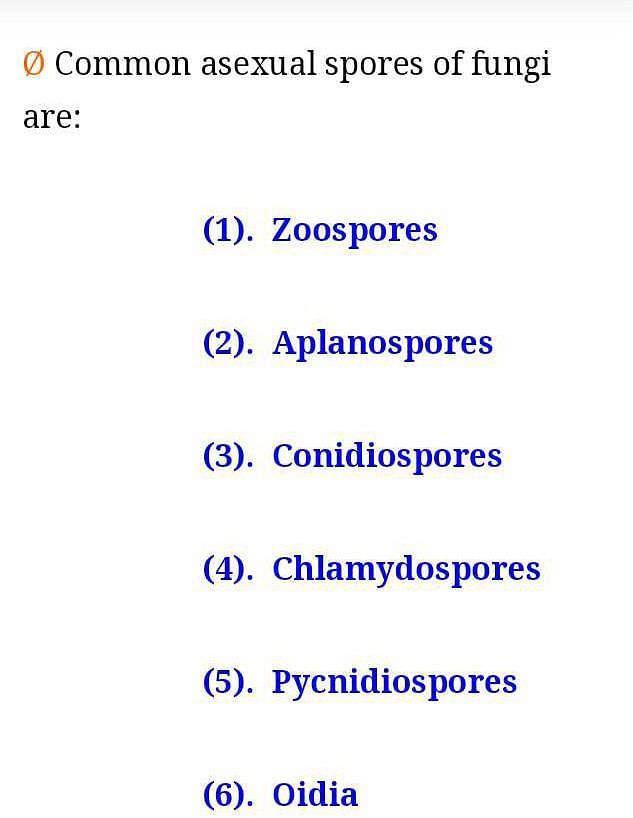NEET Exam > NEET Questions > Most common type of asexual spore in FUNGI?
Start Learning for Free
Most common type of asexual spore in FUNGI?
Most Upvoted Answer
Most common type of asexual spore in FUNGI?
Introduction
Fungi are a diverse group of organisms that reproduce both sexually and asexually. Asexual reproduction in fungi is mainly through spores. There are different types of asexual spores in fungi, but the most common type is the conidiospore.
What are Conidiospores?
Conidiospores, also known as mitospores, are a type of asexual spore produced by fungi. They are formed by the process of mitosis and are genetically identical to the parent fungus. Conidiospores are usually small, unicellular, and non-motile.
Formation of Conidiospores
Conidiospores are formed through a process called conidiogenesis. This process involves the development of specialized structures known as conidiophores. Conidiophores are formed from vegetative hyphae and bear the conidiospores at their tips. The conidiospores are then released into the environment, where they can germinate and develop into new fungal colonies.
Importance of Conidiospores
Conidiospores play an important role in the survival and dispersal of fungi. They can be produced rapidly and in large numbers, allowing fungi to colonize new environments and spread quickly. Conidiospores can also be adapted to different environmental conditions, allowing fungi to survive in a variety of habitats.
Conclusion
In conclusion, conidiospores are the most common type of asexual spore in fungi. They are formed through the process of mitosis and are genetically identical to the parent fungus. Conidiospores play an important role in the survival and dispersal of fungi, allowing them to colonize new environments and adapt to changing conditions.
Fungi are a diverse group of organisms that reproduce both sexually and asexually. Asexual reproduction in fungi is mainly through spores. There are different types of asexual spores in fungi, but the most common type is the conidiospore.
What are Conidiospores?
Conidiospores, also known as mitospores, are a type of asexual spore produced by fungi. They are formed by the process of mitosis and are genetically identical to the parent fungus. Conidiospores are usually small, unicellular, and non-motile.
Formation of Conidiospores
Conidiospores are formed through a process called conidiogenesis. This process involves the development of specialized structures known as conidiophores. Conidiophores are formed from vegetative hyphae and bear the conidiospores at their tips. The conidiospores are then released into the environment, where they can germinate and develop into new fungal colonies.
Importance of Conidiospores
Conidiospores play an important role in the survival and dispersal of fungi. They can be produced rapidly and in large numbers, allowing fungi to colonize new environments and spread quickly. Conidiospores can also be adapted to different environmental conditions, allowing fungi to survive in a variety of habitats.
Conclusion
In conclusion, conidiospores are the most common type of asexual spore in fungi. They are formed through the process of mitosis and are genetically identical to the parent fungus. Conidiospores play an important role in the survival and dispersal of fungi, allowing them to colonize new environments and adapt to changing conditions.
Community Answer
Most common type of asexual spore in FUNGI?

Attention NEET Students!
To make sure you are not studying endlessly, EduRev has designed NEET study material, with Structured Courses, Videos, & Test Series. Plus get personalized analysis, doubt solving and improvement plans to achieve a great score in NEET.

|
Explore Courses for NEET exam
|

|
Similar NEET Doubts
Most common type of asexual spore in FUNGI?
Question Description
Most common type of asexual spore in FUNGI? for NEET 2024 is part of NEET preparation. The Question and answers have been prepared according to the NEET exam syllabus. Information about Most common type of asexual spore in FUNGI? covers all topics & solutions for NEET 2024 Exam. Find important definitions, questions, meanings, examples, exercises and tests below for Most common type of asexual spore in FUNGI?.
Most common type of asexual spore in FUNGI? for NEET 2024 is part of NEET preparation. The Question and answers have been prepared according to the NEET exam syllabus. Information about Most common type of asexual spore in FUNGI? covers all topics & solutions for NEET 2024 Exam. Find important definitions, questions, meanings, examples, exercises and tests below for Most common type of asexual spore in FUNGI?.
Solutions for Most common type of asexual spore in FUNGI? in English & in Hindi are available as part of our courses for NEET.
Download more important topics, notes, lectures and mock test series for NEET Exam by signing up for free.
Here you can find the meaning of Most common type of asexual spore in FUNGI? defined & explained in the simplest way possible. Besides giving the explanation of
Most common type of asexual spore in FUNGI?, a detailed solution for Most common type of asexual spore in FUNGI? has been provided alongside types of Most common type of asexual spore in FUNGI? theory, EduRev gives you an
ample number of questions to practice Most common type of asexual spore in FUNGI? tests, examples and also practice NEET tests.

|
Explore Courses for NEET exam
|

|
Suggested Free Tests
Signup for Free!
Signup to see your scores go up within 7 days! Learn & Practice with 1000+ FREE Notes, Videos & Tests.

























